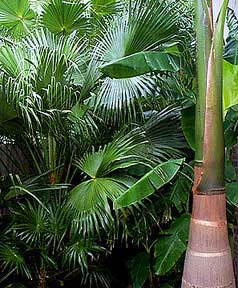Table of Contents
Palm trees, with their graceful beauty and tropical charm, are a beloved sight along the Texas Riviera. However, living in a high-wind area presents unique challenges for these majestic trees. In this article, we will explore essential practices and techniques to ensure the health and longevity of palm trees in such regions. Whether you’re a beginner or an avid gardener, these tips will help you provide the care your palm trees need.
Understanding High-Wind Areas
Living in a subtropical paradise like the Texas Riviera means experiencing occasional strong winds, especially during storm seasons. It’s crucial to understand the impact of high winds on palm trees. These trees have adapted to withstand strong gusts, but they still require extra care to thrive. By acknowledging the specific challenges posed by high-wind areas, you can take proactive steps to protect your palm trees.
Selecting Wind-Resistant Palm Tree Varieties
When choosing palm trees for your high-wind area, opt for varieties known for their resilience. Some wind-resistant species that thrive in subtropical regions include the Sabal palmetto (Cabbage Palm), Phoenix dactylifera (Date Palm), and Washingtonia robusta (Mexican Fan Palm). These trees possess unique features, such as flexible trunks and robust root systems, allowing them to endure strong winds more effectively.
Proper Planting Techniques
Successful palm tree establishment starts with proper planting techniques. Consider the following steps:
– Site selection:
Choose a location that provides some wind protection, such as against a building or natural barrier.
– Soil and drainage:
Palm trees prefer well-drained soil. In high-wind areas, ensure proper drainage to prevent waterlogging during heavy rainstorms.
– Positioning:
Plant the tree with the prevailing wind direction in mind, allowing it to lean slightly into the wind. This helps minimize stress on the trunk and root system.
Watering and Irrigation
Watering practices for palm trees in high-wind areas require careful attention. While palm trees have moderate water needs, they may require additional irrigation during windy conditions due to increased evaporation. Consider the following tips:
– Deep watering:
Provide deep watering sessions to encourage root growth and enhance stability.
– Mulching:
Apply a layer of organic mulch around the base of the tree to retain moisture and regulate soil temperature.
– Adjusting irrigation during wind events:
Monitor weather conditions and increase watering if the wind is accompanied by high temperatures or low humidity.
Pruning and Trimming
Regular pruning and trimming are vital for palm trees’ health and their ability to withstand strong winds. Follow these guidelines:
– Remove dead or yellowed fronds:
Prune these fronds to maintain a neat appearance and prevent potential hazards during storms.
– Avoid over-pruning:
While it’s essential to remove dead or damaged fronds, avoid excessive pruning, as it can weaken the tree’s structure and compromise its ability to withstand high winds.
Supporting and Stabilizing Palm Trees
In high-wind areas, providing support and stabilization to palm trees is crucial. Consider the following methods:
– Staking:
Use stakes to anchor the tree temporarily during its early growth stages until it establishes a strong root system.
– Guying systems:
Install non-abrasive materials, such as nylon straps, to secure the tree against strong winds. Ensure the
guy wires are adequately tensioned but not excessively tight to prevent damage.
Protection Against Wind Damage
During extreme wind events like hurricanes or tropical storms, extra precautions can safeguard your palm trees. Here are some protective measures:
– Covers and wraps:
Use specially designed palm tree covers or wraps to shield the trunk and crown from flying debris.
– Bracing and tethering:
Install bracing systems to reinforce the tree’s stability and minimize the risk of toppling over during severe winds.
Pest and Disease Management
Palm trees in high-wind areas are susceptible to certain pests and diseases. Implement these preventive measures:
– Regular inspections:
Routinely check for signs of pests or diseases, such as discoloration, distorted growth, or pest activity.
– Proper sanitation:
Remove fallen fronds and debris regularly to eliminate potential breeding grounds for pests.
Maintenance and Monitoring
Ongoing maintenance and monitoring are crucial to keep your palm trees healthy in high-wind areas. Consider these practices:
– Fertilization:
Apply a balanced palm tree fertilizer according to the recommended schedule to ensure optimal nutrition.
– Observing signs of stress:
Regularly inspect your trees for signs of stress, such as wilting or discolored leaves, and take appropriate action promptly.
Conclusion
Caring for palm trees in high-wind areas, such as the Texas Riviera, requires a combination of knowledge, attention, and proper techniques. By selecting wind-resistant varieties, implementing correct planting methods, and providing adequate support, you can help your palm trees thrive and withstand the challenges of strong winds.
Remember to monitor their health, practice regular maintenance, and promptly address any signs of stress. With the right care, your palm trees will continue to grace the landscape, adding beauty and tropical allure to your surroundings.
Frequently Asked Questions (FAQ) – Caring for Palm Trees in High-Wind Areas
Can all palm tree varieties withstand high winds?
While palm trees are generally resilient, not all varieties are equally equipped to handle high winds. It’s important to select wind-resistant species that are known to thrive in high-wind areas. Varieties such as Sabal palmetto (Cabbage Palm), Phoenix dactylifera (Date Palm), and Washingtonia robusta (Mexican Fan Palm) have demonstrated better resilience in windy conditions.
How often should I water my palm trees in high-wind areas?
Palm trees in high-wind areas may require more frequent watering due to increased evaporation. Deep watering is recommended to encourage proper root growth. Monitor the weather conditions, and adjust watering schedules accordingly, especially during periods of strong winds and high temperatures.
Can I prune my palm trees anytime, or is there a specific season for it?
Palm trees can be pruned throughout the year as needed, but it’s generally advisable to avoid excessive pruning during the active growing season. Removing dead or yellowed fronds regularly is important for tree health and wind resistance. Pruning during cooler months is often preferred to minimize stress on the tree.
How long should I stake my newly planted palm tree?
Staking is typically done for a limited time until the palm tree establishes a strong root system. Depending on the palm species and growth rate, staking may be necessary for around 6 to 12 months. Be mindful not to keep the tree staked for too long, as it can hinder natural trunk strengthening and growth.
Should I remove fallen fronds around my palm trees in high-wind areas?
Yes, it is important to regularly remove fallen fronds and debris around palm trees. Fallen fronds can serve as breeding grounds for pests and diseases, and they may also become hazards during strong winds. Proper sanitation helps maintain a clean and healthy environment for the palm tree’s growth.
How can I protect my palm trees during a hurricane or tropical storm?
When severe weather events are forecasted, protective measures can help safeguard palm trees. Use specialized covers or wraps to shield the trunk and crown from flying debris. Additionally, installing bracing systems and tethering the tree can provide extra stability and minimize the risk of toppling over.
Are there specific signs I should look for to identify pest or disease infestations in my palm trees?
Yes, there are several signs that may indicate pest or disease issues in palm trees. These include discoloration or browning of leaves, distorted growth patterns, the presence of pests such as scales or mites, and the appearance of fungal or bacterial lesions. Regular inspections and prompt action can help mitigate these issues.
How frequently should I fertilize my palm trees in high-wind areas?
Palm trees benefit from regular fertilization to maintain optimal nutrition. It is generally recommended to fertilize palm trees three to four times a year, with applications spaced throughout the growing season. Be sure to use a balanced palm tree fertilizer and follow the recommended dosage instructions.




